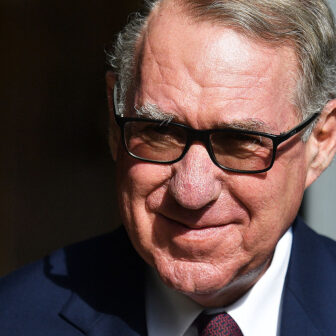AFTER the collapse of ABC Learning three years ago, childcare and early education disappeared from the media spotlight. The rise and fall of ABC was a mesmerising saga, complete with stories of high finance, lavish lifestyles and corporate intrigue. Its aftermath was sober but equally compelling, with most of ABC’s centres quietly taken over by GoodStart, a non-profit consortium involving several of Australia’s major charities, and criminal charges laid against ABC’s former CEO, Eddie Groves, and some of his business associates.
Absorbing as it was, the ABC drama deflected attention from the arduous, unspectacular but crucial work being done behind the scenes. Over the past few years, governments around Australia have adopted a new national policy framework for early education and care, agreed to deliver a year of preschool education to all children by 2013 and endorsed the phasing in of new, nationally consistent quality standards. Since 2006, total government expenditure on early education and care has increased by more than 50 per cent in real terms. Outside the world of early childhood, however, these changes are not widely known.
These are encouraging developments, but there remain traps – both in policy and implementation – that could stymie moves towards more accessible, affordable, high-quality education and care around Australia. And there is a major weakness in the new policy framework: the absence of any articulated link between responsibility for the care of children and gender equality.
IN THE early 2000s the concept of “social investment” began to frame thinking about social and economic policy in Australia. Politicians and public officials increasingly acknowledged the growing scientific and economic consensus about the importance of the early years for children’s later development, and particularly their readiness for school. Some political leaders became strong enthusiasts for these ideas. Kevin Rudd, for example, identified parent and child centres as his “one big idea” for the 2020 Summit. As the emphasis in public policy shifted from competition and microeconomic reform to more socially focused ways of building human capital and boosting labour productivity, social investment played a growing role in national economic reform debates.
It was in this context that the federal, state and territory governments, through the Council of Australian Governments, or COAG, endorsed the wide-ranging National Early Childhood Development Strategy: Investing in the Early Years. The strategy focuses on children from birth to eight years and embraces education, childcare and health as well as housing, child protection and family support. It has a particular focus on reducing inequalities between groups of children.
Building on this broad strategy, the federal, state and territory governments endorsed two national partnership agreements. The National Partnership Agreement on Early Childhood Education aims to ensure that by 2013 every child has access to fifteen hours of high quality preschool education for forty weeks in the year before starting school. Under the agreement, preschool programs can be delivered through a range of services including long day care, preschools, and family day care. The National Partnership Agreement for Indigenous Early Childhood Development includes additional measures to help “close the gap” between Indigenous and other Australian preschoolers. Strengthening this initiative, one element of the National Indigenous Reform Agreement specifically focuses on ensuring that Indigenous four-year-olds in remote communities have access to early childhood education.
Early childhood services have traditionally been regulated by the states and territories, and inconsistent regulations have been a longstanding concern. As part of the national reform agenda, a National Quality Framework will guide the licensing and quality rating of long day care, family day care, outside school hours care and preschools from January 2012. The framework introduces nationally consistent regulations and improved ratios of staff to children and requires a more highly skilled and qualified workforce in all early childhood settings. Parallel legislation will be introduced in all jurisdictions to establish a new legal and regulatory framework for early childhood education and care and lay the groundwork for a unified national system. A learning framework for the preschool years, Belonging, Being and Becoming, forms part of the new quality arrangements; a separate framework, My Time, Our Place, will apply to school-age care services.
Significant changes to staff-to-child ratios and qualifications are to be phased in over several years. By January 2014, all long day care and preschool services catering to twenty-five or more children will need to employ a qualified early childhood teacher. Half of the staff employed in each long day care centre or preschool will need to have, or be working towards, a diploma-level early childhood education and care qualification or above. Other staff in centre-based childcare and all family day carers will be required to have, or be working towards, a Certificate III level early childhood education and care qualification, or equivalent. Achieving these targets and attracting and retaining qualified professional staff in services characterised by low pay, poor promotion prospects and sometimes arduous working conditions may prove to be the critical challenge for the sector. A high proportion of the staff in long day care are currently paid at minimum award rates, have few opportunities for career progression and do not benefit financially from upgrading their qualifications.
Administrative changes at both federal and state levels reflect the emerging culture of a more integrated service system. An Office of Early Childhood Education and Child Care has been established within the federal Department of Education, Employment and Workplace Relations. As its name suggests, the Office has responsibility for both early education and care. The shift in location of responsibility for childcare from the Department of Families, Housing, Community Services and Indigenous Affairs symbolises the focus on education and employment (or, at least, human capital development) embedded in current ideas about services for young children. In complementary fashion, all states and territories have now brought responsibility for preschools into their departments of education.
THE agreements, goals, targets and other bureaucratic requirements that underpin the early childhood reform agenda represent a considerable achievement by public officials and build on decades of work by others in the sector. The long-term potential of these initiatives and reforms should not be underestimated. Nevertheless, gaps, weaknesses and inconsistencies continue to characterise Australia’s approach to early education and care.
One of the biggest risks is the reliance on private markets to deliver most Commonwealth-funded childcare services. (Preschool has not been opened up to market forces in the same way as childcare in Australia – this is one marker, a positive one, of the lack of integration between education and care to date.) The transfer of more than 650 ABC Centres to the socially oriented GoodStart consortium has certainly moved the balance of ownership back towards toward the non-profit sector. But even accounting for this shift, two-thirds of Australia’s childcare centres are operated for profit.
Under Australia’s market-based childcare system, parents are seen as consumers who purchase services in a competitive marketplace. The childcare benefit effectively operates as a voucher that parents can spend at an approved service of their choice. This is very different from preschools, where the dominant model around Australia is either a free service provided as part of the school system or a relatively low-cost community service. The issue here is not whether individual, private services can provide excellent care and education – clearly they can. The question is whether there is evidence at a system level that the market can deliver the outcomes for children envisaged in Australia’s early childhood agenda. At this stage, the research evidence suggests we should exercise considerable caution.
Market-based systems rely on the assumption that “consumers” are savvy individuals who can discipline providers by withdrawing their custom and going elsewhere if the service provided is inadequate. For markets to work, consumers need to have access to a range of providers who can provide appropriate services. Evidence suggests that these assumptions do not hold up well in respect of care services. Parents do not go into the market seeking a packaged product called “childcare”; they search for services that cater to the needs of their children (in terms of age, personality, level of ability) and they frequently require hours and days of care that mesh with their employment commitments. For many, proximity to home, work or school will be important considerations. Most parents do not have a choice between services – they are lucky if they can find one that matches their needs. Even if they have a choice, they typically purchase childcare only infrequently, and don’t have extensive experience in assessing information about quality and prices. Governments may seek to aid transparency and assist consumer choice through regulation and accreditation and by providing information about how individual services perform against standards, but not all groups have equal skills in making use of such information: an increased focus on consumerism and choice favours those with more resources and education, who have an advantage in navigating the system.
Childcare markets (and other markets in care) are quite unlike markets for products such as soap or breakfast cereal. A growing body of research shows that the real costs of switching providers are simply too high for many parents to countenance. Parents are aware that there are considerable costs in switching services and that many of these costs – ending relationships with friends and carers/educators, losing familiar environments, having to reinvest time and emotional energy to settle into a new service – are borne by children. Even when they have concerns about quality, many parents are reluctant to impose these costs on their children, and so they find themselves effectively locked in to continuing to purchase from the same provider. The “emotional economy” of care thus limits the effectiveness of market mechanisms.
THE policy-makers driving the new early childhood agenda are building on, and seeking to reshape, a complex historical legacy marked by separate roles for the federal government and the states and territories. Broadly, the federal government has focused on childcare services that meet the needs of working parents and the states have delivered educationally focused preschool programs – although this shorthand characterisation does not do justice to either tradition.
Funding mechanisms, subsidy structures and eligibility rules drive home the division between services supported by each level of government. For example, the childcare benefit and the childcare rebate, the main Commonwealth subsidies that assist parents with the costs of work-related childcare, are only available to users of approved services. To be approved, a service must meet various conditions, including being open for a minimum number of hours per day and weeks per year. Since preschools typically operate only during school terms, and offer only half days or short (six-hour) full days, most are not approved for fee relief purposes and the parents who use them cannot claim the benefit or the rebate even though in some states (particularly New South Wales) preschool can be very expensive.
The reasons why parents choose particular service types for their children are complex and multifaceted. It is far too simple to say that childcare is used to accommodate parents’ needs while preschool is a child-focused system: parents want the best for their children regardless of their own workforce status. For families whose children attend preschool so that parents can hold down jobs, the current system is incomprehensible and unfair.
While efforts to integrate education, care and health are laudable, services for young children also need to be considered in relation to the broader policy agenda. As yet, there is little evidence that this is occurring. For example, there is a notable lack of coherence between Australia’s new national paid parental leave scheme and the approach to early childhood education and care outlined here. The parental leave scheme provides eighteen weeks’ paid leave at the minimum wage for eligible families. From the child’s perspective, we could interpret this as an implicit guarantee of the possibility of six months of parental care, with public support. After that, however, there is no entitlement to care or education until the child becomes eligible for fifteen hours of preschool education in the year before formal school begins. And despite the fact that the majority of mothers are back at work before their children start school, the early childhood agenda contains no targets for providing care for one-, two- and three-year-old children and no mechanisms for linking services to areas of greatest need.
Another striking feature of Australia’s early childhood agenda is the absence of any recognition of the role of children’s services in supporting a more equal division of labour between women and men. The principles articulated in Investing in the Early Years include “a focus on the whole child,” “a focus on the whole service system” and “a focus on respect for diversity and difference” but there are no references to the connections between childcare and the promotion of gender equality. This could, in part, be a reaction by elements of the early childhood community to the perception that in the past the federal government’s focus on childcare has been excessively workforce-oriented and insufficiently focused on the interests of children. Still, the absence of even the smallest gesture towards gender equality is noteworthy. The strategy refers in a general way to “outcomes for families related to workforce participation” and the childcare reform package is featured as a gender equality measure in other government documents such as the Women’s Budget Statement, but there are no clear mechanisms that compel governments to follow through on these statements or to enable the tracking of progress towards goals.
EARLY childhood policy in Australia is undergoing profound restructuring and reform, much of it positive, though some of it less ambitious than it should be. COAG has proved to be an effective mechanism for establishing and maintaining federal leadership in the sector and significant steps have been taken towards improving quality standards, streamlining regulatory processes and strengthening the skills and qualifications of the early childhood work force. But much remains to be done. The new agenda is being built on a legacy of division between sectors, providers and levels of government. Finding effective ways to address the gaps, inconsistencies and pitfalls of this legacy is a major challenge for the implementation of Australia’s new early childhood agenda.
A parallel challenge is to develop ways of rewarding and remunerating early childhood professionals at levels commensurate with the value and importance of their work while ensuring that families, especially the most disadvantaged, are not excluded from services. If the overall goal is to provide all children with the best start in life, and to support the participation of both women and men in social and economic life, additional investment by governments and taxpayers is both inevitable and desirable. •




